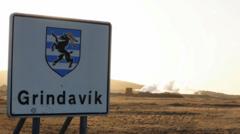In the early hours, the Iceland Meteorological Office reported a volcanic eruption near Grindavík, occurring shortly after a series of earthquakes that rattled the region. The eruption commenced at approximately 09:45 local time, leading to a significant fissure opening in the ground, which has expanded to a width of 700 meters (approximately 2,296 feet). Authorities had anticipated the potential for an eruption, leading to the evacuation of Grindavík and the well-known Blue Lagoon spa, a popular destination for tourists.
By 11:00, officials noted that the fissure had extended southward, revealing a new crack. The region's police chief, Úlfar Lúðvíksson, emphasized the urgency of leaving the area, especially as many residents had previously disregarded the evacuation orders. While most of the approximately 4,000 residents of Grindavík have been evacuated since November 2023 due to ongoing volcanic unrest, around 40 homes remained occupied during this latest event.
The eruption follows a series of volcanic activities that have taken place on the peninsula since 2021, the last significant eruption having occurred roughly 800 years ago, which spanned decades. Currently, the length of the newly formed magma tunnel spans around 11 km (6.8 miles), marking the longest measurement recorded since November 2023.
In terms of safety, the Iceland Meteorological Office has advised that smoke and gas from the eruption will likely move northeast, affecting the capital area. Overall, the eruption marks a significant geological event for Iceland, which is home to 33 active volcanic systems and lies along the Mid-Atlantic Ridge—a zone of tectonic activity and potential hazards.
By 11:00, officials noted that the fissure had extended southward, revealing a new crack. The region's police chief, Úlfar Lúðvíksson, emphasized the urgency of leaving the area, especially as many residents had previously disregarded the evacuation orders. While most of the approximately 4,000 residents of Grindavík have been evacuated since November 2023 due to ongoing volcanic unrest, around 40 homes remained occupied during this latest event.
The eruption follows a series of volcanic activities that have taken place on the peninsula since 2021, the last significant eruption having occurred roughly 800 years ago, which spanned decades. Currently, the length of the newly formed magma tunnel spans around 11 km (6.8 miles), marking the longest measurement recorded since November 2023.
In terms of safety, the Iceland Meteorological Office has advised that smoke and gas from the eruption will likely move northeast, affecting the capital area. Overall, the eruption marks a significant geological event for Iceland, which is home to 33 active volcanic systems and lies along the Mid-Atlantic Ridge—a zone of tectonic activity and potential hazards.


















